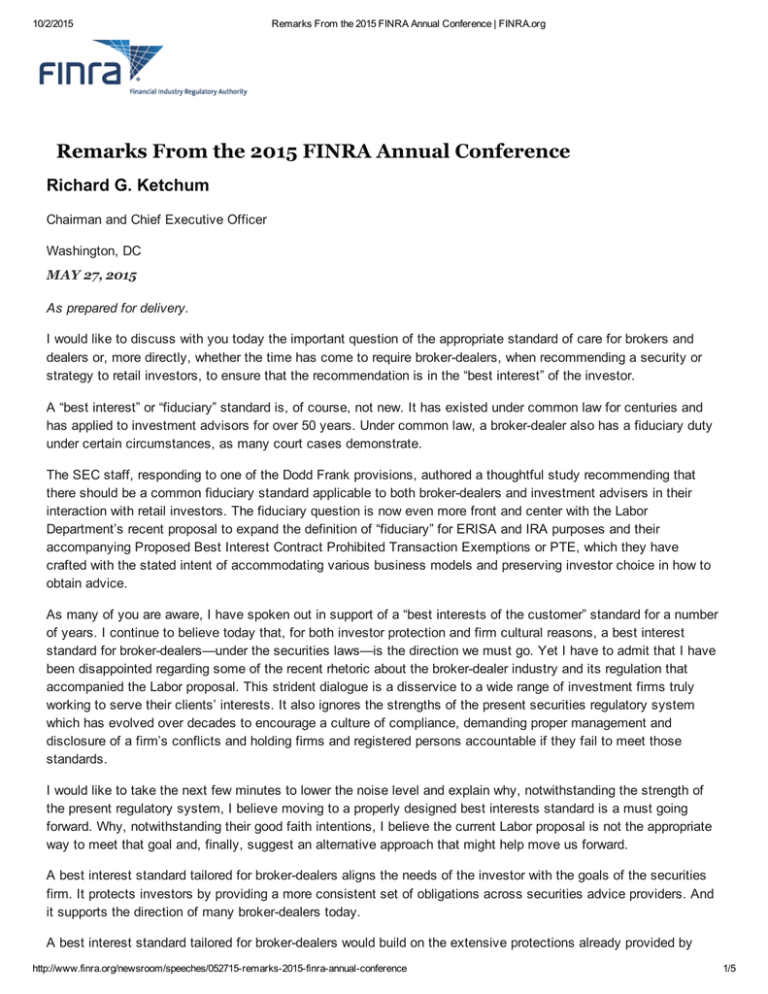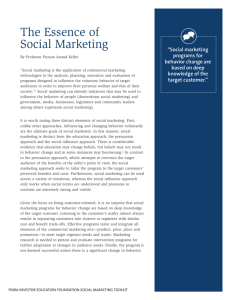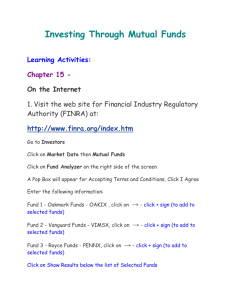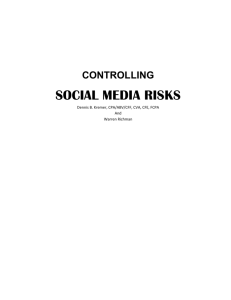Remarks From the 2015 FINRA Annual Conference Richard G. Ketchum
advertisement

10/2/2015 Remarks From the 2015 FINRA Annual Conference | FINRA.org Remarks From the 2015 FINRA Annual Conference Richard G. Ketchum Chairman and Chief Executive Officer Washington, DC MAY 27, 2015 As prepared for delivery. I would like to discuss with you today the important question of the appropriate standard of care for brokers and dealers or, more directly, whether the time has come to require broker­dealers, when recommending a security or strategy to retail investors, to ensure that the recommendation is in the “best interest” of the investor. A “best interest” or “fiduciary” standard is, of course, not new. It has existed under common law for centuries and has applied to investment advisors for over 50 years. Under common law, a broker­dealer also has a fiduciary duty under certain circumstances, as many court cases demonstrate. The SEC staff, responding to one of the Dodd Frank provisions, authored a thoughtful study recommending that there should be a common fiduciary standard applicable to both broker­dealers and investment advisers in their interaction with retail investors. The fiduciary question is now even more front and center with the Labor Department’s recent proposal to expand the definition of “fiduciary” for ERISA and IRA purposes and their accompanying Proposed Best Interest Contract Prohibited Transaction Exemptions or PTE, which they have crafted with the stated intent of accommodating various business models and preserving investor choice in how to obtain advice. As many of you are aware, I have spoken out in support of a “best interests of the customer” standard for a number of years. I continue to believe today that, for both investor protection and firm cultural reasons, a best interest standard for broker­dealers—under the securities laws—is the direction we must go. Yet I have to admit that I have been disappointed regarding some of the recent rhetoric about the broker­dealer industry and its regulation that accompanied the Labor proposal. This strident dialogue is a disservice to a wide range of investment firms truly working to serve their clients’ interests. It also ignores the strengths of the present securities regulatory system which has evolved over decades to encourage a culture of compliance, demanding proper management and disclosure of a firm’s conflicts and holding firms and registered persons accountable if they fail to meet those standards. I would like to take the next few minutes to lower the noise level and explain why, notwithstanding the strength of the present regulatory system, I believe moving to a properly designed best interests standard is a must going forward. Why, notwithstanding their good faith intentions, I believe the current Labor proposal is not the appropriate way to meet that goal and, finally, suggest an alternative approach that might help move us forward. A best interest standard tailored for broker­dealers aligns the needs of the investor with the goals of the securities firm. It protects investors by providing a more consistent set of obligations across securities advice providers. And it supports the direction of many broker­dealers today. A best interest standard tailored for broker­dealers would build on the extensive protections already provided by http://www.finra.org/newsroom/speeches/052715­remarks­2015­finra­annual­conference 1/5 10/2/2015 Remarks From the 2015 FINRA Annual Conference | FINRA.org broker­dealer regulation. The SEC and FINRA, of course, regulate virtually all aspects of a broker­dealer’s business. The overarching principle that drives that regulatory structure is that a broker­dealer “hangs out a shingle” that implicity represents that it will deal fairly with the public. While the shingle theory does not generally assume that broker­dealers are fiduciaries, brokers with investment or trading discretion or effective control over a customer’s account have been deemed to be fiduciaries. Time constraints this morning prevent me from giving a detailed analysis of the breadth of the SEC and FINRA regulatory requirements, but there are broad­based fair dealing, just and equitable principles of trade, suitability and supervision requirements. It is important to underline that the rules require that brokers perform due diligence on a product they recommend to ensure that it is reasonably suitable for any customer and is also suitable for the specific client based on his or her needs, sophistication, risk tolerance and financial circumstances. FINRA rules are backed by an active program that examines all broker­dealers, depending on their size and activity, none less than every four years and, for large firms, every year. Through our risk­based programs, this resulted in nearly 6,800 cycle, cause and branch office examinations in 2014 alone. Moreover, our rules are also backed by an active enforcement program. In the last five calendar years, FINRA brought 8,271 disciplinary actions against registered individuals and firms. Over that time, we expelled 107 firms from the securities industry, barred 2,345 individuals, and suspended another 3,417 from associating with FINRA­regulated firms—and ordered over $100 million in restitution to investors. Combine that with strong written supervisory requirements and comprehensive oversight of firms’ advertising to ensure both fairness and balance and the result is a very strong and effective regulatory framework. In addition, FINRA rules and their enforcement have consistently addressed conflicted advice and self­dealing. In particular there are limits on compensation, required disclosure of various conflict circumstances and prohibited transactions. Our rules (i) restrict the payment of non­cash compensation to broker­dealers and registered representatives in connection with the sale of mutual funds, variable annuities, and various other products, (ii) prohibit recommendations of investment companies whose 12b­1 fees and sales loads exceed the caps in our rule, (iii) require that principal trades, commissions, fees and expenses must be disclosed to the customer and (iv) require that revenue sharing arrangements with mutual funds generally must be disclosed if they form a basis for the selection of funds that the broker­dealer recommends. Moreover, in recent years, we have implemented additional, wide ranging suitability, supervision and disclosure requirements with respect to variable annuities and, more recently, imposed new account statement requirements regarding non­public REITs and DPPs. Finally, this summary doesn’t even address the detailed disclosure and conflict management requirements imposed on firms’ investment banking and analyst activities. Through rule adoption and enforcement actions, the SEC and FINRA have adjusted regulatory requirements to address many conflict issues. Moreover, our Conflicts Report emphasizes that many financial firms have made progress in improving their conflict management process by, among other things, (i) increasing the independence of their private wealth groups in making product selection and product approval decisions, (ii) increasing the availability of third party, non­proprietary products, (iii) improving the disclosure regarding product and administrative fees and (iv) improving their supervision of product sales that involve higher commission and fee incentives. And we explicitly point out in our Conflicts Report that it is an effective practice for firms to adopt a best interest of the customer standard. While this summary is not, in any way, meant to suggest that the present regulatory system is perfect, it does show that depictions of the present environment as providing “caveat emptor” freedom to broker­dealers to place investors in any investment that benefits the firm financially with no disclosure of their financial incentives or the risks of the product, are simply not true. Nor are they an accurate starting point to justify a new standard of care. Notwithstanding the effectiveness and fundamental integrity of the present FINRA/SEC regulatory structure for broker­dealers, I continue to believe that it is the right time to move forward to a best interest standard for broker­ dealers. Why? http://www.finra.org/newsroom/speeches/052715­remarks­2015­finra­annual­conference 2/5 10/2/2015 Remarks From the 2015 FINRA Annual Conference | FINRA.org First, our examinations and enforcement dockets continue to reveal unacceptable instances of unsuitable sales of more complex products without the appropriate disclosure to clients of the downside risks and fees associated with the products. Second, while we provided best practice examples in our Conflicts Report of firms implementing rigorous programs to identify and aggressively manage conflicts relating to their retail client businesses, some firms continue to approach conflict management on a haphazard basis, only implementing an effective supervisory process after a failure event involving customer harm occurs. Third, despite our Notice on firms’ obligations regarding recommendations of 401(k) conversions to IRAs, we continue to be concerned that there is often not enough effort made to provide a balanced discussion of the potentially higher fees involved in IRAs to permit a customer to make a fully informed decision. In addition, there is the simple but important matter of investor confusion about today’s differing standards for broker­dealers and investment advisors. In summary, I continue to believe that the clarity of a “best interest of the customer” standard would be an important step forward in encouraging firm compliance cultures that translate to consistent actions to place the interests of the customer first. I am focused here on a broker­dealer best interest standard under the securities laws, rather than the present Labor proposal. Let me be clear that I believe that the Labor proposal was a very good faith effort to address an important investor protection imperative and clearly DOL has a special interest in recommendations to move assets out of 401(k) s and IRAs. Moreover, the core features of their relevant proposed Prohibited Transaction Exemption—the demonstration that a recommendation was in the customer’s best interest, through (i) the identification of Material Conflicts of Interest combined with adoption of procedures to prevent such conflicts from causing unbalanced advice, (ii) the management of compensation practices to avoid improper incentives for conflicted advice, and (iii) implementation of effective fee and risk disclosure requirements—are aimed at exactly the right areas. While right directionally, I have practical concerns with the Labor proposal in a number of areas. First, the warranty and contractual mechanism employed by Labor used to address their limited IRA enforcement jurisdiction, appears to me to be problematic. In one sweeping step, this moves enforcement of these provisions to civil class action lawsuits or arbitrations where the legal focus must be on a contractual interpretation. I am not certain how a judicial arbiter would analyze whether a recommendation was in the best interests of the customer “without regard to the financial or other interests” of the service provider. I’m not sure, but I suspect, a judicial arbiter might draw a sharp line prohibiting most products with higher financial incentives no matter how sound the recommendation might be. Similarly, I’m not sure how a judicial arbiter would evaluate which compensation practices “tend to encourage” violations of the exemption. It would appear likely, however, that firms would be required to demonstrate, at least, that any higher compensation was directly related to the time and expertise necessary to provide advice on the product, as specifically suggested by DOL. To say the least, making that case is not a simple proof standard. This all leads to my second concern that there is insufficient workable guidance provided either to the firm or the judicial arbiter on how to manage conflicts in most firms’ present business models other than moving to pure asset­ based fees, or a completely fee­neutral environment. It is not that Labor’s conflict concerns don’t have validity; it is that I fear that the uncertainties stemming from contractual analysis and the shortage of useful guidance will lead many firms to close their IRA business entirely or substantially constrain the clients that they will serve. Put another way, the subjective language of the PTE, coupled with a shortage of realistic guidance, may lead to few providers of these critical investor services. Finally, I believe that it is not optimal for investors to apply a different legal standard to IRAs and 401(k)s than to the rest of an investor’s assets. A great many investors simply do not plan for their retirement by segregating tax­ advantaged vehicles from their other investment strategies. An effective regulatory environment would apply a consistent best interest standard across, at least, all securities investments and have the examination and enforcement mechanisms to oversee compliance with the standard. While, for all the reasons described above, it is clear to me that the SEC is the right agency to apply a “best interest” standard to broker dealers, there is no question that designing such a standard is challenging. http://www.finra.org/newsroom/speeches/052715­remarks­2015­finra­annual­conference 3/5 10/2/2015 Remarks From the 2015 FINRA Annual Conference | FINRA.org Accordingly, in a desire to advance this important conversation, let me suggest a number of markers that might provide useful guidance in crafting a best interest standard. First, the best interest standard should make clear that customer interests come first and that any remaining conflicts must be knowingly consented to by the customer. And as I discussed above, no standard should be implemented that does not provide sufficient guidance to permit compliance with its requirements. Second, any such proposal should include a requirement that financial firms establish carefully designed and articulated structures to manage conflicts of interest that arise in their businesses. This would include creating an ongoing process to specifically identify any conflicts that might impact their provision of fair and effective investment advice and develop written supervisory procedures to address how those conflicts would be eliminated or managed. Third, any best interest standard should also begin by applying know­your­ customer and suitability standards as “belt and suspenders” backstops, similar to what is contained in FINRA’s rules. Fourth, there should be more effective disclosure provided to investors. Broker­dealers should be required to provide customers an ADV­like document annually that provides clear, plain English descriptions of the conflicts they may have and an explanation of all product and administrative fees. Moreover, the firms’ representatives should provide either point of sale disclosures regarding relevant conflict, risk and fee issues relating to a recommendation, or, in the alternative, follow up any discussion involving a recommendation with a written or email communication that memorializes the conversation by describing the key contractual terms and fees entailed in the product. Such communication, including a balanced explanation of the benefits of the product or strategy recommended as well as the potential adverse risk scenarios that the customer should be aware of, would be critical to ensure that the investor had a clear understanding of the benefits, risks and costs of the recommended investment. Finally, firms should take concrete steps to address the incentives for their registered persons from differential product compensation. One way firms might address this issue would be to follow what has become a growing best practice of creating fee neutrality across products that minimize incentives for salespersons to favor one type of product over another. For example, by providing consistent compensation for their registered persons regarding mutual fund purchases, irrespective of the load or trails resulting from the particular fund, firms could clearly demonstrate their efforts to manage the conflicts imbedded in differential fee compensation. I recognize that fee leveling may be complex or competitively problematic for some firms’ business model. Moreover, I don’t think the goal should be to eliminate all fee differences across different investment products. Alternatively, or in combination with targeted fee leveling, a firm could create targeted compliance oversight that specifically focuses on the sale of more expensive products and demands a clear rationale as to why it was in the best interests of the customers. Let me hasten to add, that this strong suite of suggestions is not meant to be exclusive but only intended as a starting point to move the conversation constructively forward. Nor does it assume that each of these requirements is equally appropriate for smaller firms, where the burden of compliance may be greater, although it can be easier at a smaller firm to create a culture of consistent compliance. Indeed, I would envision that an effective best interest standard would provide firms with the flexibility to develop alternative means of demonstrating that their recommendations are consistently in the best interests of customers. In conclusion, it is time for us to reach agreement on a best interest solution that embraces three essential tenets: active identification and management of firms’ conflicts, dramatically improved disclosure of risks associated with the product and product­related fees, firm and third party incentives, and more effective management of the compensation incentives to registered persons. It is the right time to move forward. Thanks for listening. Sitemap Privacy Legal ©2015 FINRA. http://www.finra.org/newsroom/speeches/052715­remarks­2015­finra­annual­conference 4/5 10/2/2015 Remarks From the 2015 FINRA Annual Conference | FINRA.org http://www.finra.org/newsroom/speeches/052715­remarks­2015­finra­annual­conference 5/5




